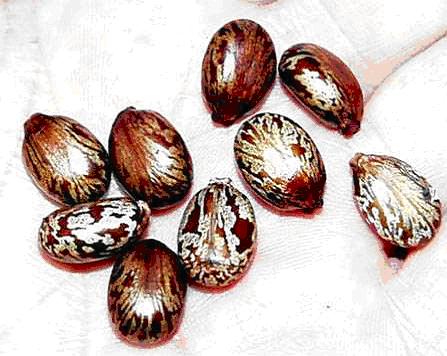 |
|
| > Welcome > Health Reporter > Ricin - Could a Deadly Poison be Similar to a Popular Food?
|
|
|
June 2, 2013 - A poison called ricin has been in the news in April and May 2013. Reports from the United States tell us that at least five letters laced with the deadly poison, ricin, have been mailed to a USA Post Office, a federal judge, a district judge, a senator, and the President of the USA, Barack Obama. We are also told that all letters were stopped by routine scanning before reaching their targets. What is this poison? Ricin is a toxic protein found in the castor beans of the castor bean plant, a native of India. Yes, the very same plant castor oil is made from (but castor oil is not deadly). Many plants produce substances to stop predators eating them. In the case of ricin, just 5-6 castor beans could kill a child, according to the National Geographic. However, this castor bean poison, ricin, becomes far more deadly when processed and refined. The ricin becomes concentrated so that just a tiny amount is deadly. Probably the most infamous assassination by ricin, carried out in cold blood was in 1985. Georgi Markov, a Bulgarian national, who was also a celebrated writer was stalked and murdered by just .2mg of ricin inserted into a small pellet and covered with wax. When the wax pellet was shot into Mr Markov’s thigh, the wax began to melt and release the deadly dose of ricin into Mr Markov’s bloodstream. He died three days later. What has this to do with everyday life? Obviously we want to avoid eating castor beans, and steer clear of the poisonous ricin. An easy task for most of us! Harder to avoid is the processed and refined “poison” lurking on every supermarket shelf, in thousands of food products, and probably hiding out in your pantry. This substance has the ability to invade and cause poison-like symptoms in the human brain, digestive system, cardiovascular system, blood joints and skin.
Ancient Healthy Grain?The shocking truth is that this substance, which billions of people believe is an ancient healthy grain, has been hybridised into something completely different. What’s more, from the late 1970’s onwards, without any testing for ill effect on animal or human, this transmogrified grain was unleashed on an unsuspecting and uninformed public.. Because there was no testing for ill effect, there is no way to prove that millions of people with symptoms ranging from skin rashes to schizophrenia are reacting to this modern grain. This grain is wheat. Is there a grain harder to avoid? From India, to China, East Asia; to Europe, the United States, Central and South America; and to us down under in Australasia and Pacifica wheat is everywhere, and seemingly in everything. And as some enlightened and observant doctors and health professionals are coming to realise, there is no corner of the human system which wheat cannot invade and cause trouble. Muscle pain, arthritis, ulcerative colitis and Crohn’s disease, other autoimmune disorders, skin rashes, bloating, obesity, type II diabetes, mood swings, neurological conditions, even contributing to heart disease and some types of cancer. Misery and suffering at every turn. Just for a moment, think about the food promoted for most styles of eating –vegan, vegetarian, omnivore, organic or non-organic - wheat often tops the popularity list! Toast or cereal for breakfast; Biscuits, scone, or muffin for morning tea; Sandwich, filled roll, wrap, pie or sausage roll for lunch; Pasta, pizza, pastry, crumbed fish, meat, or vegetables for the evening meal. Oh, and don’t forget a slice of cake for supper! Next morning, the same cycle starts again! Wheat, wheat, wheat! Even the most sceptical of us can see that a wheat-based diet is not “moderation in all things.” Here’s a challenge: Choose to take out the wheat from one meal a day – the main cooked meal may be the easiest. Replace the wheat with popular potato, plump pumpkin, kool kumara (sweet potato). Read labels! How about that favourite muesli – are oats the main ingredient, or has wheat somehow snuck into the ingredient list? What is your favourite wheat free meal? Like what you are reading? Subscribe to our newsletter.
1 Press TV, FBI arrests man in ricin letter case in Washington”published May 23, 2013. Retrieved May 28 2013 from http://www.presstv.ir/detail/2013/05/23/305041/fbi-arrests-man-in-ricin-letter-case/ 2 National Geographic Daily News “Ricin back in the headlines: What is It?” by Cathy Newman published April 17, 2013. Retrieved May 28, 2013 from http://news.nationalgeographic.com.au/news/2013/13/130417-ricin-letter-poison-obama-roger-wicker-toxicology/ 3 Wheat Belly by Dr William Davis MD published 2011 by Rodale Inc, New York, USA. Also see: http://www.wheatbellyblog.com/ The Health Reporter is contributed to by Vital Force Trustees or members and edited by Fiona Timmins. Fiona Timmins has a background in print journalism, health sector public relations, and has co-ordinated a large community health project in Wester Ross, on the north west coast of Scotland.
Posted: Sun 02 Jun 2013 |
|
|

